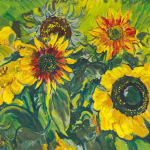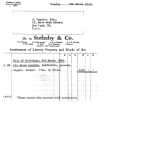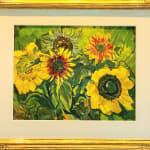


Jacob Epstein
Further images
Provenance
Ex. Coll: The artist; to Sotheby's London, March 4, 1959, lot 62; to John Dugdale, 8 East End Avenue, New York, NY, 1959 and thence by descent in the family until 2021.
Sir Jacob Epstein
British (b. NYC 1880 - London 1959)
Sunflowers, c. 1936
Gouache on paper
17 x 22 inches
Signed (at lower right): Epstein
Framed in a c. 1925-1935 period gold leaf frame. 8 ply acid free mat and optium acrylic.
Ex. Coll:
The artist; to Sotheby's, London, March 4, 1959, lot 62; to John Dugdale, 80 East End Avenue, New York, NY, 1959 and thence by descent in the family until 2021.
This painting, Sunflowers, was painted at some point between 1933 and 1939. Dutch dealers Asher & Velker commissioned Epstein to create a series of flower paintings. All measure 17 X 22 inches (either horizontal or vertical). In his autobiography Let There be Sculpture he wrote: "I said I would paint twenty... Not content with this, I went on painting, giving up sculpture for the time being…I lived and painted flowers. My rooms were piled with flowers and this was a wonderful and colourful period." (pp. 165-6).
Jacob Epstein was one of the leading British artists of the 20th century. Celebrated for his sculpture, portraits and still lives, he was a ground-breaking and controversial artist. His art, particularly his sculpture, was often highly sexualized. With great creativity Epstein celebrated the grandeur of the human experience incorporating non-western artistic influences from Africa, India and the Pacific Islands into his monumental direct carvings. His major public sculptures are found throughout Britain. Many of his portraits of luminaries including Albert Einstein and Paul Robeson and still lives are found in museum collections throughout the world including The National Portrait Gallery, London; The Tate, London and MOMA, NYC.
Born into an Orthodox Jewish family of Polish extraction, Epstein spent his childhood and adolescence in New York City. He studied at New York's renowned Art Student's League between 1896 and 1902. A scholarship to the Ecole des Beaux Arts in Paris took him to Europe. He also studied at the Academie Julian. In 1905, Epstein moved to London and by 1907 he had become a British citizen.
In 1912-13, Epstein spent time in Paris where he became acquainted with Brancusi, Modigliani and Picasso. On his return to England in 1913 he became one of the founders of the London Group. Created as an artist-run group it was anti Royal Academy, which represented the establishment. Epstein was one of 32 artists including Bomberg, Gaudier-Brzeska, Sickert and Wyndham-Lewis, who founded this group. Still extant, the London Group has exerted immense influence on the trajectory of British Art.For most of his career Epstein was represented by Leicester Gallery. In 1927 Epstein had a one-man show at New York's Ferragil Gallery and in 1953, the Art's Council organized an Epstein Retrospective at the Tate Gallery. Epstein was knighted in 1954 - recognition of his contributions to Art in Britain.


